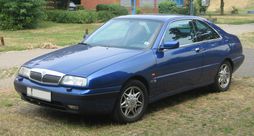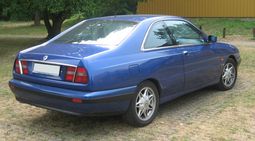The History Of Lancia Kappa

The Lancia Kappa is an executive car produced by Italian automaker Lancia. It replaced the Thema as Lancia's flagship model in 1994 and was itself replaced by Lancia Thesis in 2001. It shared its platform with the Alfa Romeo 166 and was available as a saloon, estate or coupé. The Kappa was only available in left-hand drive, as Lancia pulled out of right-hand drive markets after the demise of the Thema.
Kappa is the tenth letter of the Greek alphabet. Greek letters have frequently been used to denote Lancia models. Back in 1919, Lancia had already produced a Kappa (and its later evolutions called Dikappa and Trikappa), but these are far less known nowadays than the 1990s Kappa. In writing, Lancia often referred to the Kappa simply as the k (lower case "k"), which is fairly similar to the original Greek letter.
The Kappa was not particularly popular, with only 80,000 made in total. Italy remained Kappa's most important market, absorbing the bulk of sales. It is also worth noting that in Poland, where Fiat Auto is the biggest domestic car manufacturer, Kappas served as official government cars (replacing Themas). This boosted the Kappa's profile in that country and gave it a peculiar cachet, which is why the Kappa enjoys a solid enthusiast base there.
- 1994 - Kappa production begins.
- 1996 - An estate car joins the lineup. The naturally-aspirated 2.0-litre gasoline engine is fitted with a variable geometry inlet manifold. Inside the cabin, the seats are replaced by a new design, including new upholstery patterns.
- 1997 - The coupé is launched, while at the same time, some changes are made to the interior, trunk, suspension and engine bay, as well as new alloy wheels. Coupe production begins.
- 1998 - The 2.0L turbocharged four-cylinder engine gets replaced by the five-cylinder, while the turbodiesel was upgraded to a JTD engine. The bumper guards, previously black, are changed to body-coloured, and the base trim level, LE, is dropped, leaving only the more lavish LS and LX. At the same time, a special trim level is introduced for the turbocharged gasoline engine, called simply the "Turbo", distinguished by the lack of chrome decals around the window frames. The interior materials are also upgraded across the lineup, including the addition of a leather-wrapped steering wheel and front central armrest.
- 1999 - The other two five-cylinder engines are modified along with the air conditioning unit.
- 2000 - The Kappa gains xenon HID headlamps. Production ceased in mid-2000 (Coupé's earlier in the year).
The station wagon version of the Kappa, designated "SW" by Lancia, was designed and built by the famous Pininfarina and did not differ from the saloon exterior dimensions - the focus was clearly on presentation rather than cargo space.
The Coupé was designed and built by Maggiora and technically quite different from the saloon, having a shorter wheelbase, wider rear track and a distinctive profile with frameless doors. Despite that the front until the window screen remained identical to that of the other Kappas. It was Lancia's first coupé since 1984, when the Beta and Gamma coupés were discontinued, and remains the last Lancia to feature this body style to this day. The small capacities for this hand made car at the Maggiora factory and the relatively high price made it from first time one a rare vehicle, so only 3620 coupes were manufactured from April 1997 to March 2000, making this model a true rarity.
The Kappa had engines fitted transversely, all powering only the front wheels. They were available with either a five-speed manual or four-speed automatic transmission, unless otherwise indicated.
2.0 20V
- 1998 cc, straight-5, DOHC, 4 valves per cylinder, 146PS (144hp/ 107kW) @ 6100 rpm & 185N·m (136lb·ft) @4500 rpm
- 1998 cc, straight-5, DOHC, 4 valves per cylinder, 155PS (153hp/ 114kW) @ 6500 rpm & 186N·m (137lb·ft) @4000 rpm
- uprated to 155 PS in 1996, after the addition of a variable geometry inlet manifold, called the Variable Intake System (V.I.S) by Lancia
- modified again in 1999
- there were two versions of the manual transmission available for this engine, called Power Drive and Comfort Drive, with gear ratios optimized towards the former or the latter, respectively
- this engine was not available in the Coupé
2.4 20V
- 2446 cc, straight-5, DOHC, 4 valves per cylinder, 175PS (173hp/ 129kW) @ 6100 rpm & 230N·m (170lb·ft) @3750 rpm
- fitted with V.I.S
- slightly modified in 1999
3.0 V6 24V
- 2959 cc, V6, DOHC, 4 valves per cylinder, 205PS (202hp/ 151kW) @ 6300 rpm & 270N·m (199lb·ft) @4500 rpm
- not fitted with V.I.S
- slightly modified in 1999
2.0 16V Turbo
- 1995 cc, turbo straight-4, DOHC, 4 valves per cylinder, 205PS (202hp/ 151kW) @ 5600 rpm & 298N·m (220lb·ft) @2750 rpm
- superseded by the 5-cylinder turbo in 1998
- 5-speed manual transmission only
2.0 20V Turbo
- 1998 cc, turbo straight-5, DOHC, 4 valves per cylinder, 220PS (217hp/ 162kW) @ 6000 rpm & 309N·m (228lb·ft) @2750 rpm
- superseded the 4-cylinder turbo in 1998
- 5-speed manual transmission only
2.4 Turbo DS/ JTD
- originally a distributor-pump turbodiesel refitted with common rail in 1998 and hence referred to as JTD engine
- TDI - 2387 cc, turbodiesel straight-5, SOHC, 2 valves per cylinder, 124PS (122hp/ 91kW) @ 4250 rpm & 246N·m (181lb·ft) @2250 rpm
- JTD - 2387 cc common rail turbodiesel straight-5, SOHC, 2 valves per cylinder, 136PS (134hp/ 100kW) @ 4250 rpm & 304N·m (224lb·ft) @2000 rpm
- not available with automatic transmission or in the Coupé
From Wikipedia, the free encyclopedia
More About Lancia Kappa




|